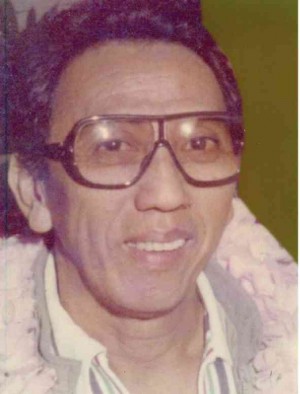Conrado Baltazar, cinematographer par excellance
I first met Conrado Baltazar when we worked together in Los Angeles, California, to buy some film equipment for the Sampaguita Pictures studio. That was in the summer of 1980. I had gone ahead to contact our former art director, Benjamin Resella, who was already working in Hollywood.
My travel companion was my boss, Marichu Maceda, who was bringing her new film, “Stepsisters,” to be shown on the US circuit. She would join me in a week’s time, but her flight was delayed, so she decided to have Carding bring the film, instead, to meet its screening date.
My diary entry for May 27, 1980 reflected my disposition: “I’m glad that Manay is sending Carding instead of someone else.” Carding, who was popularly called “Dengcar” by his fellow workers, had gained quite a reputation for his meticulous handling of film machinery. He was also the favorite cinematographer of director Lino Brocka.
It’s interesting to note that Baltazar involved himself in quite a number of film productions, but only “Salambao” (1964) made it to the Famas awards for best cinematography.
Productive decade
For nearly a decade, starting with “Insiang” in 1977, he was busy with films that made it to the honor rolls of Famas and Urian. At one time, his films ranked first for three successive years at the Urian awards, for best cinematography—for Lino Brocka’s “Gumising Ka, Maruja” (1978), “Jaguar” and “Angela Markado.”
At the Famas, he was nominated several times, for “Insiang” in 1977, “Gumising Ka, Maruja” in 1978, “Init” in 1979, “Angela Markado” and “Rubia Servios” in 1980, “Virgin Forest” and “Kapit Sa Patalim/Bayan Ko” in 1985 and “Lumuhod Ka Sa Lupa” and ‘I Love You, Mama, I Love You, Papa” in 1986.
So impressed was UP Professor Joel David, who founded the Young Critics Circle, that he commented in his book, “The National Pastime,” that “what surpasses negative comment about the film, ‘Angela Markado,’ is Baltazar’s cinematography.”
“Not since Jaguar,” says David, “for which he also took charge, has a local movie possessed such distinct visual character. What stands out in that film is Baltazar’s use of light, or more properly, his disuse of it.
Carding didn’t live long enough to reap his rewards in the recognition of critics. He was severely injured during filming—they were testing new equipment, but the camera he was holding onto safely landed on terra firma.
He was only 59 years old, and is survived by his wife, Milling Gallardo Baltazar, and four children: Robert, Lita, Jim and Cynthia.
On Tuesday, June 23, his son Jim will offer “A Tribute to His Father, Dengcar,” and to CNB, the institution Baltazar left behind to his family, commemorating 30 years of commitment to the development of Philippine cinema, video and television.
The event’s venue is the Shooting Gallery Studio at 1196 Pablo Ocampo ave. extn. corner Zapote st., Barangay Sta. Cruz, Makati.
